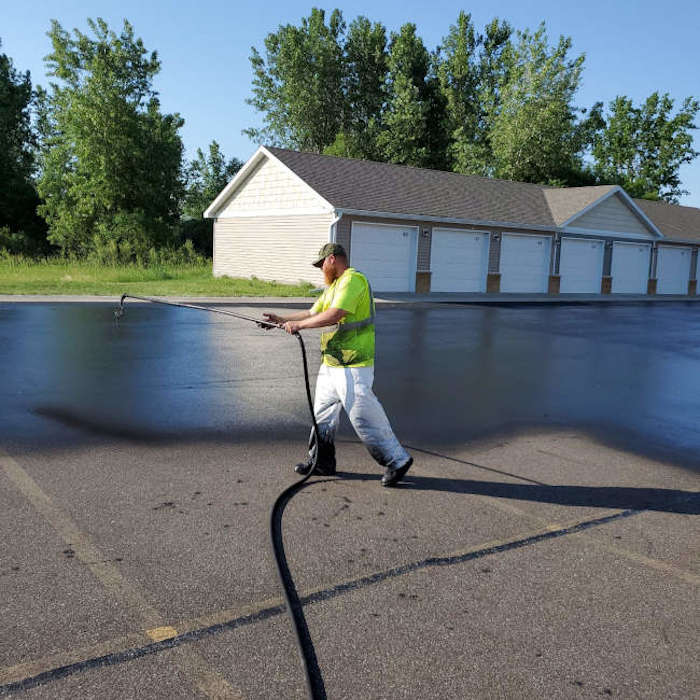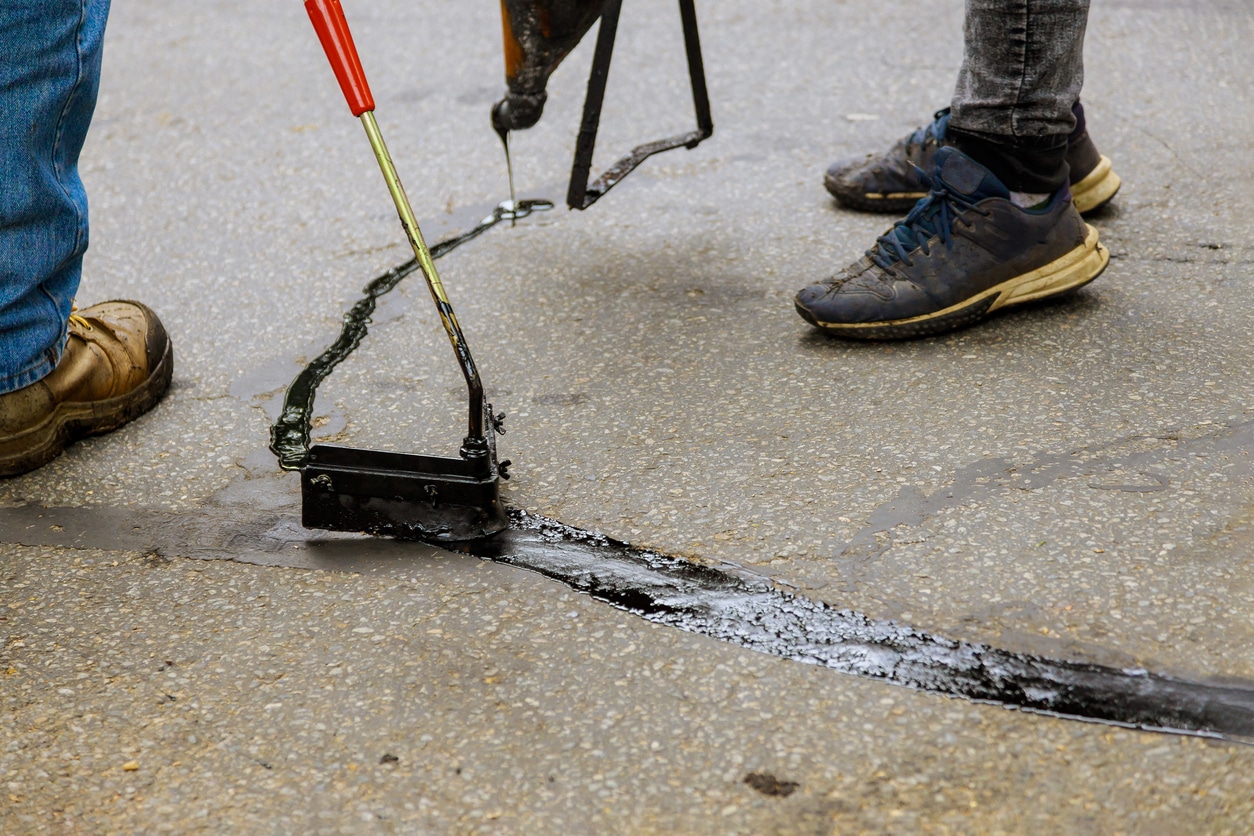Unleash the Prospective: Regrading and Asphalt Sealing for Business Areas
Unleash the Prospective: Regrading and Asphalt Sealing for Business Areas
Blog Article
Warm Mix Asphalt: A Lasting Option for Pavement
Hot Mix Asphalt (HMA) has emerged as a leading lasting option for sidewalk services, providing a myriad of environmental benefits and innovative technologies. Its capacity to reduce and reuse products power consumption presents an engaging situation for its adoption in road building and construction projects. The lasting performance and sturdiness of HMA make it a favored option for framework growth. As the demand for green building and construction techniques expands, exploring the subtleties of HMA's sustainability can give important understandings into the future of pavement remedies.
Ecological Advantages of Hot Mix Asphalt

In Addition, Warm Mix Asphalt helps to reduce city heat island impacts. Its dark shade soaks up sunshine, reducing the quantity of warmth mirrored back into the atmosphere contrasted to lighter-colored pavements. This can lower ambient temperature levels in urban areas, reducing the demand for cooling and ultimately lowering energy usage.
On top of that, Warm Mix Asphalt adds to improved stormwater administration. Its porous nature permits water to charge and penetrate the pavement groundwater products, lowering drainage and the danger of flooding. These ecological benefits make Hot Mix Asphalt a lasting option for paving roadways and freeways.
Power Effectiveness in HMA Manufacturing
Is energy performance a critical element in the manufacturing of Warm Mix Asphalt (HMA)? Energy plays a considerable role in the manufacturing of HMA, affecting both price and ecological sustainability. One vital element of power effectiveness in HMA manufacturing is the use of warm mix asphalt (WMA) modern technologies.
Furthermore, advancements in plant modern technologies have caused even more energy-efficient HMA production processes. Modern plants are designed with attributes like recycled asphalt sidewalk (RAP) handling capabilities, effective burner systems, and improved insulation, all adding to energy financial savings. By maximizing energy use in HMA production, the industry can lower its carbon footprint while preserving high-grade pavement materials. Power performance is, therefore, an essential factor to consider in ensuring the sustainability of Warm Mix Asphalt production.
Recyclability of Hot Mix Asphalt
The recyclability of Hot Mix Asphalt (HMA) is a crucial element of its sustainability and lasting environmental impact. HMA is just one of the most recycled materials in the USA, with over 100 million lots of reclaimed asphalt pavement (RAP) being recycled annually in new pavement building. Recycling HMA supplies several environmental advantages, such as decreasing the need for virgin materials, lowering energy usage during manufacturing, and lowering the amount of waste sent to land fills.
The procedure of recycling navigate to this website HMA involves crushing the existing pavement, squashing it right into smaller pieces, and blending it with brand-new aggregate and asphalt binder to develop a recycled mix. This recycled mix can often execute in addition to or even better than standard HMA, while calling for less resources and generating lower greenhouse gas exhausts. By incorporating RAP right into brand-new pavement tasks, road firms can conserve natural deposits, minimize prices, and decrease the environmental impact of road building and maintenance activities. Overall, the recyclability of HMA plays a considerable function in advertising sustainable practices within the pavement industry.

Long-Term Performance of HMA
Asphalt pavements show durability and strength over an extensive period, reflecting the lasting efficiency of Hot Mix Asphalt (HMA) The durability of HMA can be attributed to its ability to endure heavy website traffic loads, rough Get More Information weather conditions, and the impacts of aging. Studies have shown that well-designed and appropriately built HMA pavements can last for twenty years or even more with regular maintenance. The key to making the most of the long-lasting performance of HMA depends on utilizing high-grade materials, complying with best methods in building, and carrying out reliable upkeep methods. Correct drain, routine assessments, and timely repair work are necessary for preserving the architectural stability of HMA sidewalks in time. Furthermore, developments in HMA technology, such as using polymer-modified binders and warm mix asphalt, have actually additionally enhanced the durability and durability of HMA sidewalks. By focusing on top quality building and maintenance methods, HMA remains to prove itself as a affordable and sustainable remedy for lasting pavement facilities.

HMA: Resilience and Sustainability
Demonstrating both longevity and sustainability, Hot Mix Asphalt (HMA) has actually ended up being a cornerstone in the building of resilient sidewalk infrastructures - regrading. HMA's toughness stems from its capacity to stand up to hefty tons, severe weather, and high web traffic quantities, making it a trustworthy selection for roadways, highways, and flight terminal runways. The make-up of HMA, which commonly consists of aggregates, binder, and filler, plays a crucial function in enhancing its durability and resistance to damage
In addition, HMA's sustainability depends on its recyclability and energy-efficient manufacturing procedure. The capability to recycle redeemed asphalt pavement (RAP) in new HMA mixes reduces the need for virgin materials and decreases the image source ecological impact of pavement building and upkeep. In addition, the energy performance of producing HMA lies in its lower mixing temperatures contrasted to various other sidewalk materials, leading to decreased power usage and greenhouse gas discharges.
Verdict
Finally, hot mix asphalt (HMA) uses a lasting option for sidewalk with its environmentally pleasant attributes. HMA's recyclability, energy performance in production, and long-term durability make it an environment-friendly choice for road construction. By saving all-natural sources, lowering waste, and decreasing greenhouse gas discharges, HMA plays an essential duty in advertising sustainability in facilities advancement. Its capability to mitigate city heat island results better underscores its relevance in producing resilient and eco mindful pavement systems.
HMA is one of the most recycled materials in the United States, with over 100 million tons of reclaimed asphalt sidewalk (RAP) being reused each year in brand-new sidewalk building.The process of recycling HMA includes grating the existing sidewalk, squashing it into smaller sized pieces, and blending it with new aggregate and asphalt binder to create a recycled mix.Asphalt sidewalks show toughness and resilience over an extensive duration, mirroring the long-term efficiency of Warm Mix Asphalt (HMA) Furthermore, innovations in HMA innovation, such as the use of polymer-modified binders and cozy mix asphalt, have actually additionally enhanced the longevity and durability of HMA pavements. The capacity to reuse redeemed asphalt pavement (RAP) in new HMA combinations reduces the demand for virgin materials and lessens the ecological impact of sidewalk construction and upkeep.
Report this page